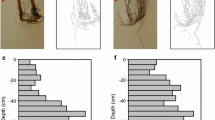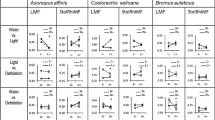Abstract
Changing biotic and abiotic stress mediate in plant–plant interactions resulting in positive to neutral or negative effects, and these effects can change with gradients of stress or through plant dynamics. Here we studied the variability in annual grass production and composition induced by gradients of intercepted light by trees in years of contrasting precipitation in Mediterranean holm oak open woodlands. Although trees reduce the light radiance received by the pasture community, the presence of trees generally had a positive effect on pasture production in average climatic years where soil fertility was low. However, the interaction changed with increasing abiotic water stress. In a dry year, the increase in fertility could not be utilized and the effect of the crown was neutral. The effect of shade turned out to be beneficial for growth, contrary to the situation in an average climatic year. Light insolation was positive for legume biomass. There was high variability in functional components over the course of the growing period and from 1 year to another. Under low levels of other biotic stresses such as livestock grazing or root competition, the limiting factor among light, soil moisture or soil nutrients may determine whether facilitation or competition occurs.





Similar content being viewed by others

References
Bellot J, Escarre A (1998) Stemflow and throughfall determination in a resprouted Mediterranean holm-oak forest. Ann Sci For 55:847–865. doi:10.1051/forest:19980708
Belsky AJ (1994) Influences of trees on savanna productivity: tests of shade, nutrients, and tree–grass competition. Ecology 75:922–932. doi:10.2307/1939416
Bertness M, Callaway RM (1994) Positive interactions in communities. Trends Ecol Evol 9:191–193. doi:10.1016/0169-5347(94)90088-4
Brooker RW, Maestre FT, Callaway RM et al (2008) Facilitation in plant communities: the past, the present, and the future. J Ecol 96:18–34. doi:10.1111/j.1365-2745.2008.01373.x
Callaway RM, Walker LR (1997) Competition and facilitation: a synthetic approach to interactions in plant communities. Ecology 78:1958–1965
Callaway RM, Nadkarni NM, Mahall BE (1991) Facilitation and interference of Quercus-Douglasii on understory productivity in central California. Ecology 72:1484–1499. doi:10.2307/1941122
Cubera E, Moreno G (2007) Effect of single Quercus ilex trees upon spatial and seasonal changes in soil water content in dehesas of central western Spain. Ann Sci 64:355–364. doi:10.1051/forest:2007012
Eviner VT, Chapin FSIII (2003) Functional matrix: a conceptual framework for predicting multiple plant effects on ecosystem processes. Annu Rev Ecol Evol Syst 34:455–485. doi:10.1146/annurev.ecolsys.34.011802.132342
Frazer GW, Canham CD, Lertzman KP (1999) Gap Light Analyzer (GLA): imaging software to extract canopy structure and gap light transmission indices from true-colour fisheye photographs, users manual and program documentation. Simon Fraser University, Burnaby, BC, and the Institute of Ecosystem Studies, Millbrook
Gea-Izquierdo G (2008) Modelos silvopascícolas en sistemas adehesados del Oeste de la Península Ibérica. PhD Dissertation. Universidad Politécnica de Madrid, Madrid
González Bernáldez G, Morey M, Velasco F (1969) Influences of Quercus ilex rotundifolia on the herb layer at the El Pardo forest (Madrid). Bol R Soc Española Hist Natu (Biol) 67:265–284
Hauggaard-Nielsen H, Jensen ES (2005) Facilitative root interactions in intercrops. Plant Soil 274:237–250. doi:10.1007/s11104-004-1305-1
Henkin Z, Seligman NG, Kafkafi U et al (1998) ‘Effective growing days’: a simple predictive model of the response of herbaceous plant growth in a Mediterranean ecosystem to variation in rainfall and phosphorus availability. J Ecol 86:137–148. doi:10.1046/j.1365-2745.1998.00243.x
Joffre R, Rambal S (1993) How tree cover influences the water balance of Mediterranean rangelands. Ecology 74:570–582. doi:10.2307/1939317
Kenward MG, Roger JH (1997) Small sample inference for fixed effects from restricted maximum likelihood. Biometrics 53:983–997. doi:10.2307/2533558
Koerselman W, Meuleman AFM (1996) The vegetation N:P ratio: a new tool to detect the nature of nutrient limitation. J Appl Ecol 33:1441–1450. doi:10.2307/2404783
Ludwig F, de Kroon H, Prins HHT et al (2001) Effects of nutrients and shade on tree–grass interactions in East-African savannas. J Veg Sci 12:579–588. doi:10.2307/3237009
Ludwig F, de Kroon H, Berendse F et al (2004) The influence of savanna trees on nutrient, water and light availability and the understorey vegetation. Plant Ecol 170:93–105. doi:10.1023/B:VEGE.0000019023.29636.92
Luis Calabuig E, Gómez Gutiérrez JM, García Criado L (1980) Evolución de fracciones de gramíneas, leguminosas y otras familias en pastizales de zona de dehesa. Pastos 10:108–137
Maestre FT, Valladares F, Reynolds JF (2005) Is the change of plant–plant interactions with abiotic stress predictable? A meta-analysis of field results in arid environments. J Ecol 93:748–757. doi:10.1111/j.1365-2745.2005.01017.x
Marañón T (1986) Plant species richness and canopy effect in the savanna-like “dehesa” of SW-Spain. Ecologia Mediterranea 12:131–141
Marañón T, Bartolome JW (1994) Coast live oak (Quercus agrifolia) effects on grassland biomass and diversity. Madrono 41:39–52
Montalvo MI, García B, Luis E et al (1980) Influencia del arbolado sobre la composición química de la hierba. An Edafologia Agrobiol 39(7–8):1287–1305
Moreno G (2008) Response of understorey forage to multiple tree effects in Iberian dehesas. Agric Ecosyst Environ 123:239–244. doi:10.1016/j.agee.2007.04.006
Mosquera MR, McAdam J, Rigueiro A (eds) (2005) Silvopastoralism and sustainable land management. CAB International, Wallingford
Olea L, San Miguel A (2006) The Spanish dehesas: a traditional Mediterranean silvopastoral system linking production and nature conservation. Grassl Sci Eur 11:3–13
Pérez Corona ME, García Ciudad A, García Criado B et al (1995) Patterns of aboveground herbage production and nutritional quality structure on semiarid grasslands. Commun Soil Sci Plant Anal 26:1323–1341. doi:10.1080/00103629509369375
Pérez Corona ME, Vázquez de Aldana BR, García Criado B et al (1998) Variation in nutritional quality and biomass production of semiarid grasslands. J Range Manag 51:570–576. doi:10.2307/4003378
Puerto A, Rico M (1992) Spatial variability on slopes of Mediterranean grasslands: structural discontinuities in strongly contrasting topographic gradients. Vegetatio 98:23–31. doi:10.1007/BF00031634
Rhoades CC (1997) Single-tree influences on soil properties in agroforestry: lessons from natural forest and savanna ecosystems. Agrofor Syst 35:71–94. doi:10.1007/BF02345330
SAS Institute Inc (2004) SAS/ETS 9.1 user’s guide. SAS Institute In, Cary
Somarriba E (1988) Pasture growth and floristic composition under the shade of guava (Psidium guajava L.) trees in Costa Rica. Agrofor Syst 6:153–162
Thevathasan NV, Gordon AM (2004) Ecology of tree intercrop** systems in the North temperate region: experiences from southern Ontario, Canada. Agrofor Syst 61:257–268. doi:10.1023/B:AGFO.0000029003.00933.6d
Verbeke G, Molenberghs G (2000) Linear mixed models for longitudinal data. Editorial Springer-Verlag, Nueva York
Vetaas OR (1992) Micro-site effects of trees and shrubs in dry savannas. J Veg Sci 3:337–344. doi:10.2307/3235758
Acknowledgments
We gratefully acknowledge Alfonso San Miguel and Darío Martín Benito for discussion and helpful comments. We thank Ángel Bachiller, Estrella Viscasillas, Manuel M. Sánchez and the students that helped with sample processing and R. Calama for statistical discussion. Special thanks to the ‘Dehesón del Encinar’ and Celia López Carrasco for facilitating the set up of the study and providing metorological data.
Author information
Authors and Affiliations
Corresponding author
Rights and permissions
About this article
Cite this article
Gea-Izquierdo, G., Montero, G. & Cañellas, I. Changes in limiting resources determine spatio-temporal variability in tree–grass interactions. Agroforest Syst 76, 375–387 (2009). https://doi.org/10.1007/s10457-009-9211-4
Received:
Accepted:
Published:
Issue Date:
DOI: https://doi.org/10.1007/s10457-009-9211-4



